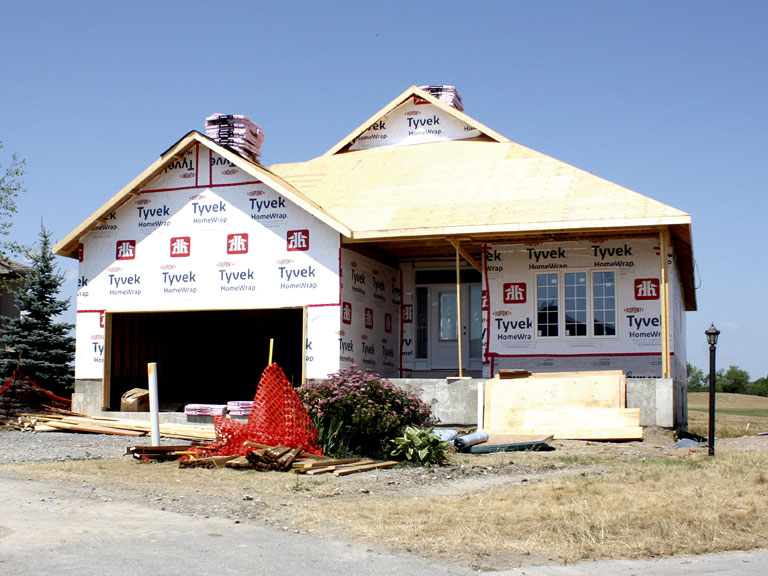County News
Limbo

Wellington on the Lake sees last house built as building in the village grinds to a halt
An age-old adage couldn’t be more true: All good things must come to an end. This is the case, as ground was broken early last month on the last building lot in Wellington on the Lake. This brings the subdivision, and its approximately 600-homes to a close. For Sandbank Homes developer Conrad Guziewicz—the most active builder in the County over the last decade—it was a bittersweet ending. “I got involved in the late 2000s with this project, and it has been rewarding, right until the last shovel went in the ground. The local economic spinoff has been extraordinary.” Guziewicz also estimates that for every two houses built, one job is added to the local economy.

The final house in the Wellington on the Lake subdivision is slated for completion later this summer
Guziewicz does have another project in the pipeline. Wellington Bay Estates, which sits at the eastern end of the village, is currently in the approval process. The proposed subdivision would see 176 units in the first phase—20 of those being dual semidetached units. The development also owns land stretching north to the Millennium Trail, which could see an additional 200 units in the future. Martin Mazierski, President of Wellington Bay Estates, says the process has been long. “We submitted the plan last June, and have been going back and forth with the County. The current filing reflects multiple changes and revisions that have been made to earlier versions of the plan in response to feedback from County staff, going back to 2017,” said Mazierski. He is hopeful that there will be a statutory meeting in the next couple of months, and then the project can go before council for final approval.
The idea for the subdivision is new age. An age in place model, with health tracking. Residents would wear a device that monitors various physiological indicators. The device sends information to a doctor on site. “It’s all about being preventative instead of reactive,” says Guziewicz. The device would allow problems to be found before it is too late. “This also allows folks to stay in their homes longer, avoids forcing people in to retirement homes, and takes the strain off of local long-term care homes,” he adds.
New home building permit numbers in the County have taken a steep decline in the first quarter of 2020. To date, there have been 42 new home permits issued totalling $21,517,726 in construction value. Last year at this time, there were 84, amounting to $41,240,052. This also cuts in half the permit fees that the municipality collects. Mazierski is concerned about the ramifications should building not commence in the village. As he has run out of inventory at his Wellington on the Lake project, he has left more than 200 workers he indirectly employs in limbo. “I have no more stock. If this subdivision plan doesn’t go forward, it would have dire consequences to the community and local economy,” he says.
New homes are much needed in the County economy. The resale market remains a tough place in for first-time homebuyers. The inventory of homes for sale is well short of the demand. Combined with still-growing demand, the average price of resale homes continues to climb. That pressure is unlikely to ease until there is a strong and steady supply of new homes built in Prince Edward County. This is why a lack of new home builds is startling.
In comparison, our neighbours to the north and west are on track for great years. To date, Belleville has issued 85 new home building permits. Quinte West has issued 94. At the end of last year, council decided not to extend the 50 per cent development charge discount which was put in place in December of 2018.
Even at the discounted rates, the County’s development and connection charges are 50 per cent higher than in Belleville—80 per cent higher in unserviced areas. Belleville, too, discounts its development charges in some neighbourhoods— extracting as little as a third of the County’s discounted charge from builders. Quinte West’s development and connection charges amount to a bit more than half of the discounted charges for the same services in the County. Another stark comparison.
But why does this matter? The answer lies in the County’s stagnant population numbers. In 1998, the tax levy—the amount required from County taxpayers needed to fund its operations— was a little over $10 million. Today, the tax levy is more than four times greater at $40.3 million. Yet the population of the County has barely changed in the intervening years. This ultimately means that the rising costs of taxes, water and garbage are spread across an unchanged number of residents—25,000 then and 25,000 now. So everyone pays more. But not everyone can afford to pay more.
New folks coming to the County are largely only replacing those leaving. For many, the County is simply no longer an affordable place to live.

The water bills are unsustainable. It’s just crazy to expect residents to pay this, and rate increases coming in 2021.